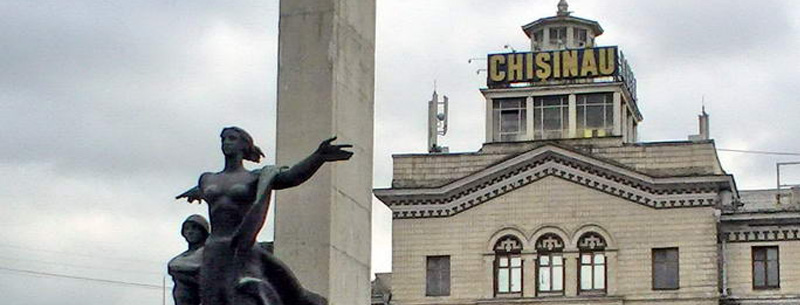Chisinau, capital city of Moldova
Chisinau is a funky city where traffic is dominated by shiny BMWs, young people strut down the boulevards in the latest fashions, and locals feast in fancy restaurants. Citizens of the good-natured city love to have a good time, and visitors will quickly feel at home among the concrete esplanades, busy main drags, swinging nightclubs and pleasant parks.
One of the most visited sights in the country is the Holy Gates of Chisinau. Built in 1846, the gates hold a 6.4-ton bell cast from Turkish cannons. Sixteen Corinthian columns provide support for the arched upper level, and the marble tablets on the sides tell the story of the 1944 liberation of the capital from German-Romanian invaders.
Just outside of the city lies Serpeni, a memorial complex commemorating the 12,000 Soviet soldiers killed during the liberation of the Republic of Moldova. Built in 1944, the complex contains a marble sanctuary engraved with the names of national heroes who died nearby. An eternal flame burns in the center.
Not far from Chisinau is the awe-inspiring archaeological complex of Old Orhei. The city of Shehr al-Cedid was established at the site in the early 14th century. The town of Orhei formed in the mid-16th century, and the open-air museum is home to many natural wonders. Numerous caves wait to be explored in the cliffs and hills, many of which once housed Christian monasteries. Although some of the caves have been damaged by earthquakes, many are well-preserved. Visitors can also explore the ruins of a 3rd-century BC fortress and the sprawling Medieval fortress that later housed the town’s magistrate.
Chisinau is home to a small number of interesting museums. One of the most intriguing is the National Museum of History, established in 1983. Visitors are greeted by a copy of a Romulus and Remus statue, then lead into ten exhibition halls showcasing over 300,000 historic and cultural treasures. The ground-floor permanent collection teaches visitors about life in Moldova from the Stone Age through the 20th century. Notable pieces on display include a 4th-century BC battle chariot, an 18th-century map of Moldova and centuries-old bronze and vermeil artifacts.
Moldova’s oldest museum, the National Museum of Ethnography and Natural History, is also one of its best. Founded in 1889, the museum is divided into two parts. The first celebrates the flora and fauna of Moldova, tracing the evolution of the country’s natural landscape from the Achaean era. The second half illuminates the cultures and traditions of the local people. Other galleries highlight collections of zoological, archaeological, paleontological, and numismatic artifacts. The museum is also home to the country’s first botanical garden.
Chisinau has a high concentration of theaters, including some of the best in the region. At the Russian Dramatic Theater, actors put on classic plays by Shakespeare, Pushkin, Gogl, Chekhov and Moliere, while the National Theater often showcases Moldovan performances. Other popular theaters in the city include the Republican Theater, the Ginta Latina Theater and the National Youth Dramatic Theater., which performs mainly contemporary plays.
One of the best times to visit Chisinau is during early March, when locals celebrate the arrival of the spring season with the Martisor festival. Throughout the month, locals don colorful flowers on their clothing and celebrate with song, dance and plenty of delicious foods.
Chisinau Geographical Location
Chisinau is in the southern area of Moldova although it is still centrally located between its east and west borders to Romania and Ukraine. It is considered the industrial center of the country.
The population of Chisinau’s metropolitan area is approximately 790,000 people.
Chisinau Language
Moldovan, which is a dialect of Romanian, is the official language in Chisinau. Russian and Gagauz is also spoken in Moldova although not as widely.
Chisinau Predominant Religion
- 98% Eastern Orthodox
- 1.5% Jewish
- 0.5% Baptist and other
- Moldova is religiously tolerant although there are laws that may indirectly restrict certain religious practices.
Chisinau Currency
- The Moldovan Leu is the official language of Moldava.
- Chisinau Climate
- It can snow quite often during the winter months in Chisinau and rains frequently in the summer. The summer temperatures are mild and the city has been known to get very cold during the winter.
Chisinau Main Attractions
- Wine Cellar Tours
- National Museum of Ethnography and Natural History
- The Holly Gates
Other Attraction in Chisinau
- Serpeni Foothold
- Nistru Beach
- Chisinaus Botanical Garden
- The Moldovan National Ballet and National Opera
